Jingchuan Wang
RaCalNet: Radar Calibration Network for Sparse-Supervised Metric Depth Estimation
Jun 18, 2025Abstract:Dense metric depth estimation using millimeter-wave radar typically requires dense LiDAR supervision, generated via multi-frame projection and interpolation, to guide the learning of accurate depth from sparse radar measurements and RGB images. However, this paradigm is both costly and data-intensive. To address this, we propose RaCalNet, a novel framework that eliminates the need for dense supervision by using sparse LiDAR to supervise the learning of refined radar measurements, resulting in a supervision density of merely around 1% compared to dense-supervised methods. Unlike previous approaches that associate radar points with broad image regions and rely heavily on dense labels, RaCalNet first recalibrates and refines sparse radar points to construct accurate depth priors. These priors then serve as reliable anchors to guide monocular depth prediction, enabling metric-scale estimation without resorting to dense supervision. This design improves structural consistency and preserves fine details. Despite relying solely on sparse supervision, RaCalNet surpasses state-of-the-art dense-supervised methods, producing depth maps with clear object contours and fine-grained textures. Extensive experiments on the ZJU-4DRadarCam dataset and real-world deployment scenarios demonstrate its effectiveness, reducing RMSE by 35.30% and 34.89%, respectively.
UNO: Unified Self-Supervised Monocular Odometry for Platform-Agnostic Deployment
Jun 08, 2025Abstract:This work presents UNO, a unified monocular visual odometry framework that enables robust and adaptable pose estimation across diverse environments, platforms, and motion patterns. Unlike traditional methods that rely on deployment-specific tuning or predefined motion priors, our approach generalizes effectively across a wide range of real-world scenarios, including autonomous vehicles, aerial drones, mobile robots, and handheld devices. To this end, we introduce a Mixture-of-Experts strategy for local state estimation, with several specialized decoders that each handle a distinct class of ego-motion patterns. Moreover, we introduce a fully differentiable Gumbel-Softmax module that constructs a robust inter-frame correlation graph, selects the optimal expert decoder, and prunes erroneous estimates. These cues are then fed into a unified back-end that combines pre-trained, scale-independent depth priors with a lightweight bundling adjustment to enforce geometric consistency. We extensively evaluate our method on three major benchmark datasets: KITTI (outdoor/autonomous driving), EuRoC-MAV (indoor/aerial drones), and TUM-RGBD (indoor/handheld), demonstrating state-of-the-art performance.
SN-LiDAR: Semantic Neural Fields for Novel Space-time View LiDAR Synthesis
Apr 11, 2025Abstract:Recent research has begun exploring novel view synthesis (NVS) for LiDAR point clouds, aiming to generate realistic LiDAR scans from unseen viewpoints. However, most existing approaches do not reconstruct semantic labels, which are crucial for many downstream applications such as autonomous driving and robotic perception. Unlike images, which benefit from powerful segmentation models, LiDAR point clouds lack such large-scale pre-trained models, making semantic annotation time-consuming and labor-intensive. To address this challenge, we propose SN-LiDAR, a method that jointly performs accurate semantic segmentation, high-quality geometric reconstruction, and realistic LiDAR synthesis. Specifically, we employ a coarse-to-fine planar-grid feature representation to extract global features from multi-frame point clouds and leverage a CNN-based encoder to extract local semantic features from the current frame point cloud. Extensive experiments on SemanticKITTI and KITTI-360 demonstrate the superiority of SN-LiDAR in both semantic and geometric reconstruction, effectively handling dynamic objects and large-scale scenes. Codes will be available on https://github.com/dtc111111/SN-Lidar.
SALT: A Flexible Semi-Automatic Labeling Tool for General LiDAR Point Clouds with Cross-Scene Adaptability and 4D Consistency
Mar 31, 2025
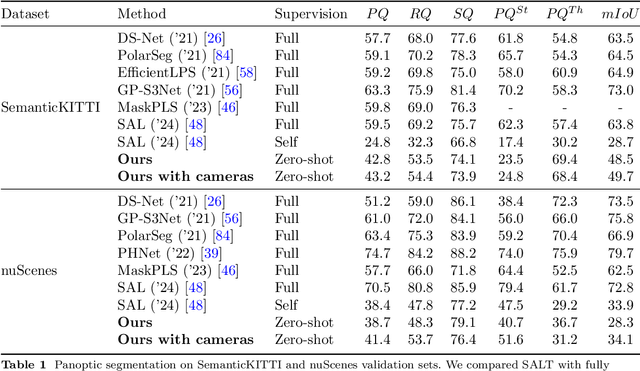
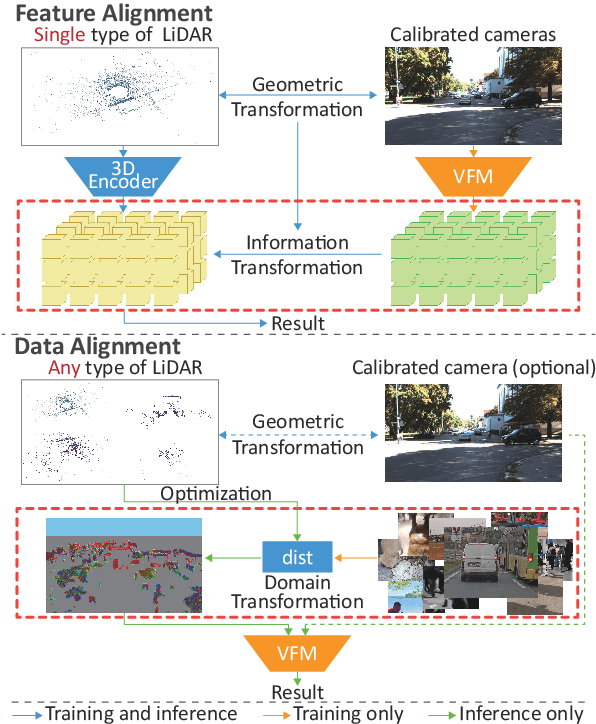
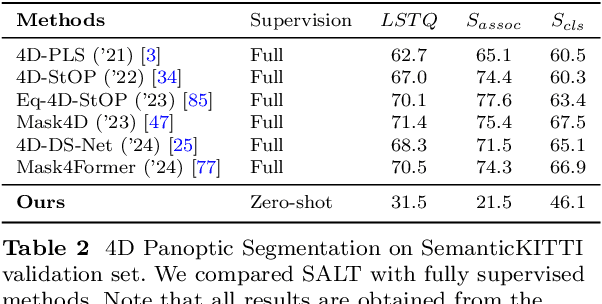
Abstract:We propose a flexible Semi-Automatic Labeling Tool (SALT) for general LiDAR point clouds with cross-scene adaptability and 4D consistency. Unlike recent approaches that rely on camera distillation, SALT operates directly on raw LiDAR data, automatically generating pre-segmentation results. To achieve this, we propose a novel zero-shot learning paradigm, termed data alignment, which transforms LiDAR data into pseudo-images by aligning with the training distribution of vision foundation models. Additionally, we design a 4D-consistent prompting strategy and 4D non-maximum suppression module to enhance SAM2, ensuring high-quality, temporally consistent presegmentation. SALT surpasses the latest zero-shot methods by 18.4% PQ on SemanticKITTI and achieves nearly 40-50% of human annotator performance on our newly collected low-resolution LiDAR data and on combined data from three LiDAR types, significantly boosting annotation efficiency. We anticipate that SALT's open-sourcing will catalyze substantial expansion of current LiDAR datasets and lay the groundwork for the future development of LiDAR foundation models. Code is available at https://github.com/Cavendish518/SALT.
SFPNet: Sparse Focal Point Network for Semantic Segmentation on General LiDAR Point Clouds
Jul 16, 2024Abstract:Although LiDAR semantic segmentation advances rapidly, state-of-the-art methods often incorporate specifically designed inductive bias derived from benchmarks originating from mechanical spinning LiDAR. This can limit model generalizability to other kinds of LiDAR technologies and make hyperparameter tuning more complex. To tackle these issues, we propose a generalized framework to accommodate various types of LiDAR prevalent in the market by replacing window-attention with our sparse focal point modulation. Our SFPNet is capable of extracting multi-level contexts and dynamically aggregating them using a gate mechanism. By implementing a channel-wise information query, features that incorporate both local and global contexts are encoded. We also introduce a novel large-scale hybrid-solid LiDAR semantic segmentation dataset for robotic applications. SFPNet demonstrates competitive performance on conventional benchmarks derived from mechanical spinning LiDAR, while achieving state-of-the-art results on benchmark derived from solid-state LiDAR. Additionally, it outperforms existing methods on our novel dataset sourced from hybrid-solid LiDAR. Code and dataset are available at https://github.com/Cavendish518/SFPNet and https://www.semanticindustry.top.
Incremental Joint Learning of Depth, Pose and Implicit Scene Representation on Monocular Camera in Large-scale Scenes
Apr 09, 2024Abstract:Dense scene reconstruction for photo-realistic view synthesis has various applications, such as VR/AR, autonomous vehicles. However, most existing methods have difficulties in large-scale scenes due to three core challenges: \textit{(a) inaccurate depth input.} Accurate depth input is impossible to get in real-world large-scale scenes. \textit{(b) inaccurate pose estimation.} Most existing approaches rely on accurate pre-estimated camera poses. \textit{(c) insufficient scene representation capability.} A single global radiance field lacks the capacity to effectively scale to large-scale scenes. To this end, we propose an incremental joint learning framework, which can achieve accurate depth, pose estimation, and large-scale scene reconstruction. A vision transformer-based network is adopted as the backbone to enhance performance in scale information estimation. For pose estimation, a feature-metric bundle adjustment (FBA) method is designed for accurate and robust camera tracking in large-scale scenes. In terms of implicit scene representation, we propose an incremental scene representation method to construct the entire large-scale scene as multiple local radiance fields to enhance the scalability of 3D scene representation. Extended experiments have been conducted to demonstrate the effectiveness and accuracy of our method in depth estimation, pose estimation, and large-scale scene reconstruction.
NeSLAM: Neural Implicit Mapping and Self-Supervised Feature Tracking With Depth Completion and Denoising
Mar 29, 2024


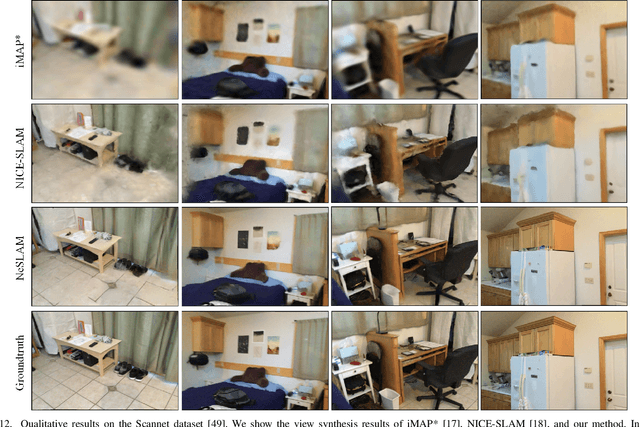
Abstract:In recent years, there have been significant advancements in 3D reconstruction and dense RGB-D SLAM systems. One notable development is the application of Neural Radiance Fields (NeRF) in these systems, which utilizes implicit neural representation to encode 3D scenes. This extension of NeRF to SLAM has shown promising results. However, the depth images obtained from consumer-grade RGB-D sensors are often sparse and noisy, which poses significant challenges for 3D reconstruction and affects the accuracy of the representation of the scene geometry. Moreover, the original hierarchical feature grid with occupancy value is inaccurate for scene geometry representation. Furthermore, the existing methods select random pixels for camera tracking, which leads to inaccurate localization and is not robust in real-world indoor environments. To this end, we present NeSLAM, an advanced framework that achieves accurate and dense depth estimation, robust camera tracking, and realistic synthesis of novel views. First, a depth completion and denoising network is designed to provide dense geometry prior and guide the neural implicit representation optimization. Second, the occupancy scene representation is replaced with Signed Distance Field (SDF) hierarchical scene representation for high-quality reconstruction and view synthesis. Furthermore, we also propose a NeRF-based self-supervised feature tracking algorithm for robust real-time tracking. Experiments on various indoor datasets demonstrate the effectiveness and accuracy of the system in reconstruction, tracking quality, and novel view synthesis.
PLGSLAM: Progressive Neural Scene Represenation with Local to Global Bundle Adjustment
Dec 15, 2023



Abstract:Neural implicit scene representations have recently shown encouraging results in dense visual SLAM. However, existing methods produce low-quality scene reconstruction and low-accuracy localization performance when scaling up to large indoor scenes and long sequences. These limitations are mainly due to their single, global radiance field with finite capacity, which does not adapt to large scenarios. Their end-to-end pose networks are also not robust enough with the growth of cumulative errors in large scenes. To this end, we present PLGSLAM, a neural visual SLAM system which performs high-fidelity surface reconstruction and robust camera tracking in real time. To handle large-scale indoor scenes, PLGSLAM proposes a progressive scene representation method which dynamically allocates new local scene representation trained with frames within a local sliding window. This allows us to scale up to larger indoor scenes and improves robustness (even under pose drifts). In local scene representation, PLGSLAM utilizes tri-planes for local high-frequency features. We also incorporate multi-layer perceptron (MLP) networks for the low-frequency feature, smoothness, and scene completion in unobserved areas. Moreover, we propose local-to-global bundle adjustment method with a global keyframe database to address the increased pose drifts on long sequences. Experimental results demonstrate that PLGSLAM achieves state-of-the-art scene reconstruction results and tracking performance across various datasets and scenarios (both in small and large-scale indoor environments). The code will be open-sourced upon paper acceptance.
Unsupervised Learning of Depth, Optical Flow and Pose with Occlusion from 3D Geometry
Mar 02, 2020
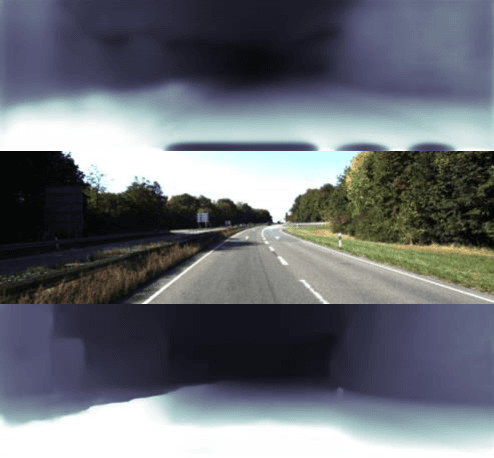
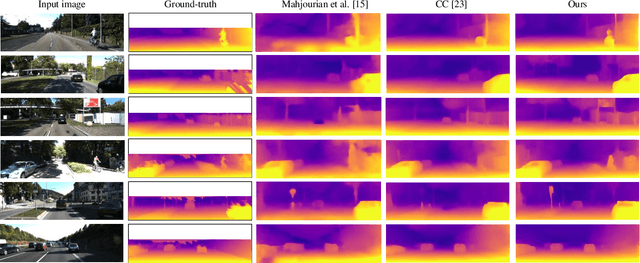
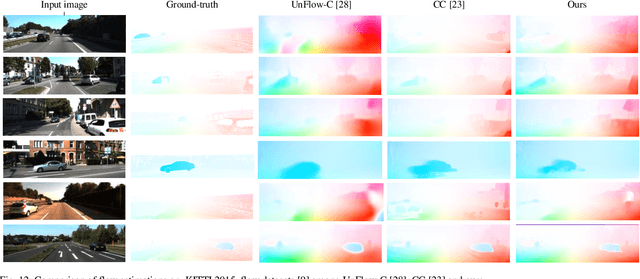
Abstract:In autonomous driving, monocular sequences contain lots of information. Monocular depth estimation, camera ego-motion estimation and optical flow estimation in consecutive frames are high-profile concerns recently. By analyzing tasks above, pixels in the first frame are modeled into three parts: the rigid region, the non-rigid region, and the occluded region. In joint unsupervised training of depth and pose, we can segment the occluded region explicitly. The occlusion information is used in unsupervised learning of depth, pose and optical flow, as the image reconstructed by depth, pose and flow will be invalid in occluded regions. A less-than-mean mask is designed to further exclude the mismatched pixels which are interfered with motion or illumination change in the training of depth and pose networks. This method is also used to exclude some trivial mismatched pixels in the training of the flow net. Maximum normalization is proposed for smoothness term of depth-pose networks to restrain degradation in textureless regions. In the occluded region, as depth and camera motion can provide more reliable motion estimation, they can be used to instruct unsupervised learning of flow. Our experiments in KITTI dataset demonstrate that the model based on three regions, full and explicit segmentation of occlusion, rigid region and non-rigid region with corresponding unsupervised losses can improve performance on three tasks significantly.
 Add to Chrome
Add to Chrome Add to Firefox
Add to Firefox Add to Edge
Add to Edge